Jessica P - Dec 14, 2023
LIGHTING FOR INDOOR SOCCER

- Download PDF
PERFECT LIGHTING
Regardless of the right name to call it by: Soccer,
futbol or football...It’s a game that traces back to the Mesoamerican period of the Aztecs. Iterations of the sport have spanned thousands of years and a large geography including China, Greece, Rome and beyond.
It was the British however that were the ones to develop the game into the FIFA empire that shakes stadiums and fans today. Luckily human sacrifices aren’t part of the rules any more although some impassioned fans can make it feel that.
In Canada, soccer is surprisingly the most popular sport in terms of player participation with over one million players enrolled according to data released in 2022.
It’s a game with a short season that gets love year round especially in the Americas. Indoor soccer actually developed because of demand for it in cold climates such as Canada and is all the rage in Mexico and the U.S.A..
Ultimately, indoor soccer lighting is aiming to simulate natures overcast conditions without the arctic temperatures.
Indoor playing and soccer training is now feasible with
a variety of dome style structures sometimes known as fieldhouses. These are built to last.
To create standardized, impactful lighting; durable, high performance fixtures must be installed to as part of a comprehensive and custom engineered lighting plan designed to meet your building system specifications and use of space.
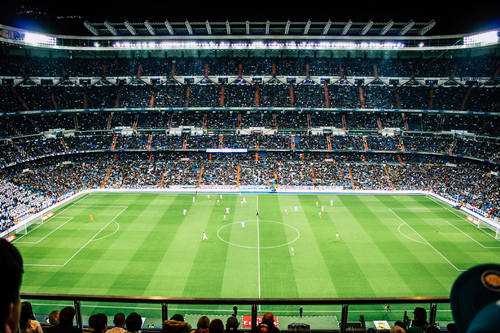 Contact Us for a Free Consult
Contact Us for a Free ConsultINDOOR SOCCER DOME LIGHTING
Soccer balls move on average at speeds of up to 120km/ hour but have gone above 200km when sent by the Ronaldos of the world.
Preventing injury and providing visual comfort is crucial for the game. Players need to be able to see clearly without eye strain which is often caused by underlighting, glare and having to overcompensate when there are hot and dark spots in the visual field from lack of uniformity which is all too common especially with legacy lighting.
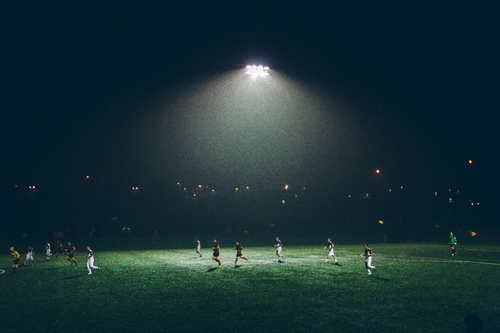
Indoor sports facilities present a unique set of requirements for lighting that we know how to tackle.
Dome structures are unique structures and extremely complex to light because of lack of contrast in the interior and having to preferably avoid, or not being able to mount fixtures overhead at all.
Unlike traditional buildings; walls, beams and an array of hanging points, a dome structure has various limitations and providing uniformity is riddled with challenges.
Fieldhouse domes have various ceiling types but generally the approach to lighting is consistent in terms of guidelines and using high performance, energy efficient indirect lighting. The calculations to deliver the right light in the right locations is where our experts come in to customize it for your venue.
The optimal way to light dome structures is to mount direct/ indirect units along the perimeter at a specific distance AFF (above finished floor) that provides the optimal reflectance on and off the surface of the ceiling while taking other building features into account.
UPGRADING/RETROFIT CONSIDERATIONS
When comparing legacy lighting with LEDs, ample light levels need to be delivered for today’s players and spectators alike. A properly lit indoor field is crucial to the flow of the match, visual comfort and everyone’s safety.
Indoor soccer lighting should be balanced with direct and indirect sources to highlight the ball in three dimensional perspective without casting shadows on players, the field or the ball and goal posts.
There are also existing fenestrations such as windows and skylights to consider in addition to other fixtures to be calculated and adapted for optimal mounting and beam angles.
Energy efficiency and savings are a given in this situation and we can also calculate the cost of payback for you.
The products we would recommend for indoor soccer domes and fieldhouses are the COURTSIDER & POOLSIDER NEO.
FLEXIBILITY & CONTROLS
In addition to upgrading to more efficient LEDs, in combination with the latest controls technologies that have been simplified for end users, a range of products offer immediate flexibility and energy cost reduction as part of a holistic approach to lighting according to your facilities changing needs throughout the day and year.
Playing with colourful lights for tournaments, eliminating start up times, and adjusting levels and focus in select zones are just some of the features that controls systems provide. Empowering facility managers to program
lights as needed and monitor energy consumption in an intelligent way is the new metric.
ILLUMINANCE & GUIDELINES
The most important lighting requirement to take into consideration is the Illuminance - the level of light on a surface. It’s measured in Lux (Lx).
Since you’re curious, a “Lux” is one lumen per square meter. Lumen is the SI unit of the incident luminous flux, which is the light emitted by a lamp.
Depending on the playing level and age range dimensions and lighting requirements this will vary.
Again, simulating an overcast sky is the aim achieved by ideally 70% direct and 30% indirect which is what strikes the ideal ratio for this artificial effect.
Suggested Levels:
• Recreational Level/Parks: 20-30fc
• High School Level: 30-50fc
• College Level: 50fc
• Division I College Level: 75-100fc
• Televised National (FIFA standards): 130-190fc
• Televised International (FIFA standards): 170-225fc
PLAYING AREA
A large symmetrical playing area, sometimes with multiple fields needs to be uniformly lit with minimal obstruction. Some venue will treat the ceiling with a different finish to create contrast.
The spectator and perimeter areas also need to be lit accordingly.
Made up of artificial turf, indoor soccer fields on average can range from 140 and 210 feet long by 60 and 90
feet wide at the professional league end and get much smaller for youth soccer clubs.
Because the rules are adapted for a more confined game indoors with walls and a ceiling this usually means a faster, more intensive game with balls bouncing off walls which may be permitted to stay in play.
Players move fast on this ground level game but spends as much time in the air.
BROADCAST
Fixture placement and hitting the target illuminance levels both vertical and horizontal are key to providing an approved, standardized environment as recognized by governing associations to meeting current broadcast standards and often to satisfy modern building codes.
For broadcast, significantly higher illuminance levels are specifically required for vertical lux and prevent flicker on screen. With controls and planning, lights can adapt for daily needs and future events of all formats.
On and off screen, this fast and dramatic game with all eyes on the ball requires perfect lighting during matches for all ages and levels of play that translates into high definition broadcast for fans everywhere. As of much importance is crisp colour rendering for jersey colours and referee cards. LEDs are truly the best at delivering color fidelity.
Correct uniformity has significant value on both the horizontal and vertical planes. It helps to correct
most camera issues according to camera angles and physiologically it is an essential factor that prevents adaptation issues for both players and spectators to be able to visually interpret the game.
UNIFORMITY
Uniformity is the ratio between the minimum and maximum illuminance (Emin / Emax) or between the minimum and average (Emin / Emed).
Some sports, such as tennis, are also based on another uniformity value called the Uniformity Gradient (UG). This is expressed as the ratio of the illuminance levels at two adjacent measurement points. For the American National Standards, it must not exceed 1.2.
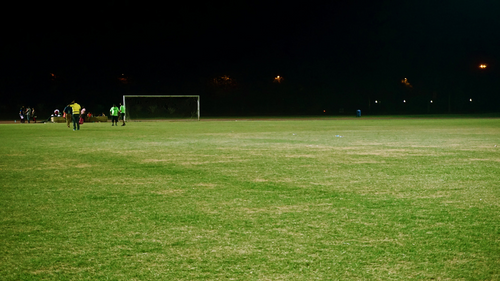
LUMINOUS EFFICACY
The luminous efficacy are numbers that translate fixture performance into operating expenses and comparison of the best product value for your investment. These numbers also simply indicate the luminous flux/ lumens produced.
Once divided into the absorbed power expressed in “Watts” the best efficiency value helps us in choosing the best product to use. LED lamps are the most suitable as they have a luminous efficacy that varies between 120 and 150 lm/W which out performs other legacy lamps.
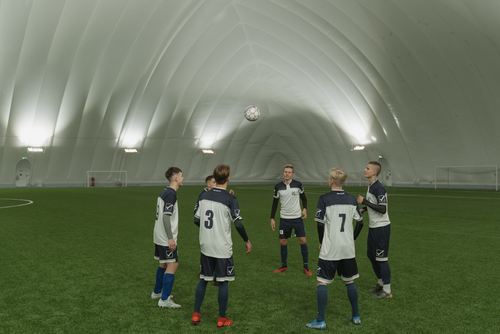 Contact Us for a Free Consult
Contact Us for a Free ConsultQUANTITY OF LIGHTS
The value of Luminous Efficacy and lamp performance will help the designers determine the number of lights needed which can vary depending on configuration of the space and it’s structure.
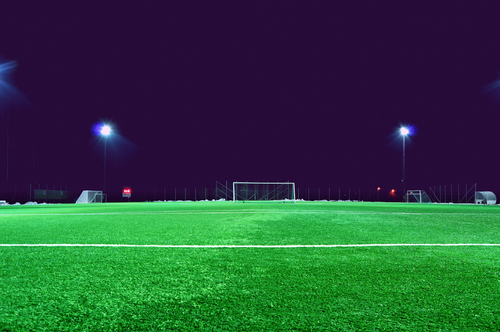
GLARE
When glare is excessive, it can cause discomfort, reduced vision and even momentary vision loss.
How can we reduce glare on an indoor soccer field? By using a combination of indirect and lighting solutions that are strategically placed with the necessary protective accessories applied so that balls don’t get caught or cause damage to the fixtures.
The International Commission on Illumination introduced Glare Rating (GR).
GR is used to evaluate the level of glare at a point for a single line of sight. GR has a range of 10 to 90, where 10 is considered “unnoticeable,” and 90 is considered “unbearable.” The acceptable level of glare rated for professional play sits in the middle at GR50.

KEY LIGHTING TERMS TO TAKEAWAY
The main metrics computed for better indoor soccer lighting are:
• Illuminance/ Brightness: This refers to the light reflecting from an object. This controls contrast which affects seeing. High contrasts prevent the ball from being seen properly and casting shadows.
• Glare: Good lighting shouldn’t cast direct glare on any surface or cause disability or strain to players eyes.
• Uniformity: Fixture aiming and beam spreads determine uniform coverage over the entire tennis court to avoid casting shadows and or creating hot or dark spots.
• Luminaire quantity: The number of lights needed to properly illuminate the baseball field and minimize shadows
• Placement: Further to the correct product, location and beam spread maximize luminaire efficiency and not interfere with items like score boards, and audio systems.
RECOMMENDATIONS
To achieve ideal lighting, the interplay between daylight and artificial light, infrastructure such as HVAC, and materials colours and finishes should be assessed as part of the overall design of your lighting system. We are familiar in collaborating with other project stakeholders and contractors to ensure a cohesive and compatible system that integrates flawlessly. Products we recommend are the DOME BAY and POOLSIDER.
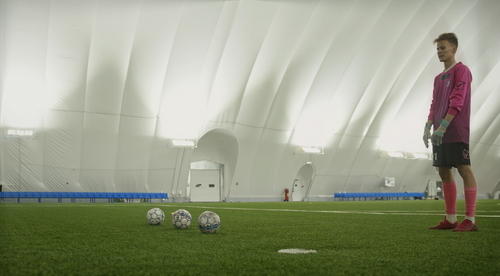
OUR SERVICES
• Free design assist services: We are glad to direct you on the best way to use our products and design your facility. Feel free to contact us for assistance
• Retrofitting: Through our easy-to-use customer contact services, you can tell us your existing lighting specifications. Let us know if you desire a “one for one” replacement with same specifications or require a new more efficient upgrade
• Energy Management: We can assist you in lowering your total overall energy and maintenance costs by switching to longer lasting more energy efficient LED Lighting
• Spare part services: With our extensive range of products and customer satisfaction at heart, we provide spare parts for our lighting systems
CONCLUSION
As in any sport, athletes need to develop their skills and the game, even at the most elite level and tools such as the right lighting are essential to this. Soccer club and soccer organizations are growing at a fast and steady rate. If you’re ready to save on costs and create lifetime members with an LED upgrade to your current lighting system and reputation, our expert team is ready to assist. Please reach out and we will connect you with your personal agent and trained design team to get you started. Gol, Gol, Gol!!!
Contact Us for a Free ConsultOUR SOLUTIONS
DOME BAY
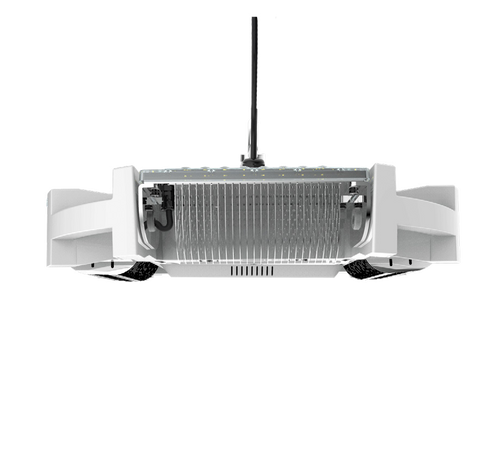
WATTAGE: 100W/150W/200W/240W/300W/400W/480W
CCT: 3000K/4000K/5000K/6500K
VOLTAGE: 100-277V (UNV) / 277-480V (HV)
MOUNTING: EYE BOLT / PENDANT MOUNT
150LM/W
The Dome Bay is an extremely versatile, Direct /Indirect, highperformance LED sports high bay that is ideal for both outdoor and indoor sports lighting applications. With its flexible, modular design the Dome Bay is specifically engineered to illuminate swimming pools, tennis and soccer domes, gyms, arenas and more.
• LED Driver: Lumileds
• Lumen Maintenance @L70: >50,000 hours
• CRI: RA>80
• THD: <15%
• Power Factor: >0.95
• Operating Temperature: -40ºC to 60ºC / -40ºF to 140ºF
POOLSIDER
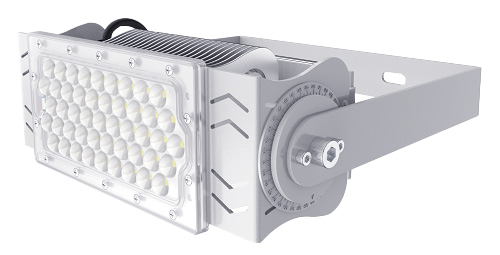
WATTAGE: 60W/100W/150W/200W/300W/400W/600W
CCT: 2700K/3000K/4000K/5000K/6500K
VOLTAGE: 120-277V (UNV) / 277-480V (HV) (REMOTE
DRIVERS ONLY)
MOUNTING: YOKE MOUNT (STD) / PENDANT MOUNT / CROSS ARM BRACKET
170LM/W
The Poolsider is a modular LED flood light specifically designed for the caustic environment of Natatoriums, but versatile enough to be used in any flood light application. Multiple optical lens choices, and rotatable modules allow a wide variety of light spread for various use both indoor and out.
• LED Engine: Philip Lumileds 50502, CREE 3524 for 10D ONLY
• LED Driver: Meanwell XLG
• Lumen Maintenance @L70: 75,000 hours
• CRI: >70 Ra
• Power Factor: >0.95
• Operating Temperature: -40ºC to 60ºC / -40ºF to 140ºF
- Download PDF
FAQ
REACH OUT TO US TO HAVE YOUR SOCCER RELATED QUESTIONS ANSWERED - WE’RE ALWAYS HAPPY TO RESPOND TO YOU!
1. Can high power LED lights be a good substitute for metal halide?
The answer is an absolute yes! We have many high- powered LED floodlights and sports luminaires designed specifically for use in tennis courts. They can easily replace 1000 watt, 1500 watt, 2000 watt, even 3500 watt metal halides, and have high quality, durable and energy saving lighting effects.
2. What’s the most suitable CCT (Colour Temperature) for tennis lighting?
Most of our clients choose 5000k/5700k for their tennis court lighting.
